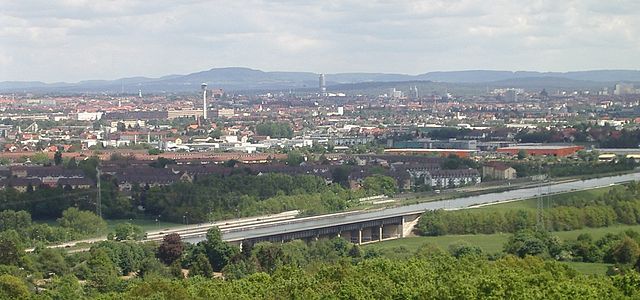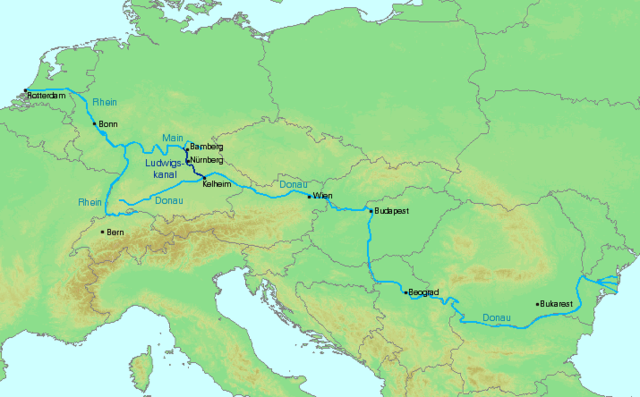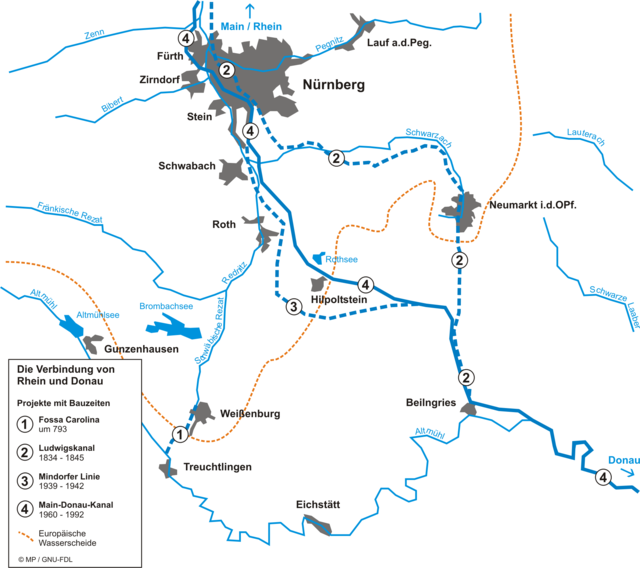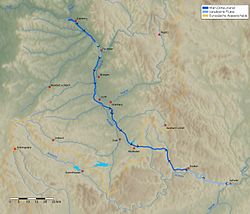Rhine–Main–Danube Canal
Canal in Bavaria, Germany From Wikipedia, the free encyclopedia
Canal in Bavaria, Germany From Wikipedia, the free encyclopedia



| Rhine-Main-Danube Canal | |
|---|---|
 The RMD Canal from Bamberg to Kelheim | |
| Specifications | |
| Length | 171 km (106 mi) |
| Maximum boat length | 190 m (623 ft) |
| Maximum boat beam | 11.45 m (38 ft) |
| Maximum boat draft | 4 m (13 ft) |
| Locks | 16 |
| Maximum height above sea level | 406 metres (1,332 ft) |
| Total rise | North: 175 metres (574 ft); South: 68 metres (223 ft) |
| Navigation authority | Federal Waterways and Shipping Administration |
| History | |
| Date completed | 1992 |
| Geography | |
| Start point | Main at Bamberg, Germany |
| End point | Danube at Kelheim, Germany |
 | |
The Rhine–Main–Danube Canal (German: Rhein-Main-Donau-Kanal; also called Main-Danube Canal, RMD Canal or Europa Canal), is a canal in Bavaria, Germany. Connecting the Main and the Danube rivers across the European Watershed, it runs from Bamberg via Nuremberg to Kelheim. The canal connects the North Sea and Atlantic Ocean to the Black Sea, providing a navigable artery between the Rhine delta (at Rotterdam in the Netherlands), and the Danube Delta in south-eastern Romania and south-western Ukraine (or Constanța, through the Danube–Black Sea Canal). The present canal was completed in 1992 and is 171 kilometres (106 mi) long.
Projects for connecting the Danube and Rhine basins by canal have a long history. In 793, the Emperor Charlemagne ordered the construction of a canal—the Fossa Carolina (German: Karlsgraben)—connecting the Swabian Rezat, a tributary of the Rednitz, to the Altmühl near Treuchtlingen. Between 1836 and 1846 the Ludwig Canal (German: Ludwigskanal), named for King Ludwig I of Bavaria, was built between Bamberg and Kelheim. This canal had a narrow channel, with many locks, and a shortage of water in the peak section, so the operation of the waterway soon became uneconomic—especially given the rapidly advancing construction of the railway network in the southern German countryside. The canal finally was abandoned in 1950, after a decision was made to not repair damage it had suffered from Allied bombing during World War II.
In 1917, the Landtag of Bavaria passed a law calling for the development of a major shipping route "between Aschaffenburg and Passau", with the capacity to carry the 1,200-ton ships used on the Rhine. On 13 June 1921, Bavaria and the German Reich concluded an agreement to build the "Main-Donau-Wasserstraße".[1] Under this plan, in addition to the expansion of the Main and Danube, a completely new channel linking the rivers was to be created. The Rhein-Main-Donau AG (RMD-AG) was founded on 30 December 1921 to undertake the project. To finance the waterway, the RMD was given control of the water resources of the Main, Danube, Lech, Altmühl, and Regnitz.[2]
The first concrete plans for the new waterway emerged in 1938, for the so-called Mindorfer Linie south of Nuremberg. As early as 1939 the first preparatory work began at Thalmässing in Landkreis Roth. However, after the war this route was dropped. By 1962, the Main's channel had been expanded as far upstream as Bamberg. In 1966, the Duisburger Vertrag, an agreement between Bavaria and the Federal Republic of Germany, was reached for financing the completion of the project. The contract was signed on 16 September of that year in Duisburg by Federal Transport Minister Hans-Christoph Seebohm, Federal Finance Minister Rolf Dahlgrün, Bavarian Prime Minister Alfons Goppel and the Bavarian Finance Minister Konrad Pöhner.
The last section to be built, between Nuremberg and Kelheim, became politically controversial in the 1970s and 1980s, mainly because of the 34-kilometre (21 mi) long section through the Altmühl valley. On 25 September 1992, the canal was completed. The equivalent of some 2.3 billion euros were invested in the construction from 1960 to 1992. Almost 20 percent of that went for environmental protection projects.
From Bamberg to Fürth the canal follows the valley of the Regnitz, a tributary of the Main. From Fürth to beyond Roth it follows the valley of the Rednitz, a tributary of the Regnitz. It crosses the Franconian Jura mountains and joins the river Altmühl near Dietfurt. From Dietfurt to Kelheim on the Danube the canal follows the Altmühl valley.
Today, some 60 kilometers of the Ludwig Canal still exists in good condition between Nuremberg and Berching. Some of the locks still function, and part of the towpath has been converted to a cycle track.[3] The old canal comes close to the new canal at Pollanten, and from there the two canals flow downstream in parallel, eventually meeting 5km south of Berching.

The cross-section of the waterway is normally trapezoidal, with 31 metres (102 ft) width at the bottom, 55 metres (180 ft) width at the water surface, 4 metres (13 ft) of water depth, and a side grade of 1:3. The channel is a Waterway Class Vb; the largest authorised vessel is 190 metres (620 ft) long and 11.45 metres (37.6 ft) wide. The channel in the Kelheim-bound Bamberg lock has a depth of 2.70 metres (8.9 ft). In the few sections with a rectangular profile, the width is usually 43 metres (141 ft) (i.e., the mean between top and bottom widths).
The length of the canal is 171 kilometres (106 mi); the summit elevation (between the Hilpoltstein and Bachhausen locks) is 406 metres (1,332 ft) above sea level. This is the highest point on Earth that is currently reached by commercial watercraft from the sea.[4]
The height difference along the north ramp of the canal—from the Main at Bamberg to the crest elevation—is 175 metres (574 ft), with 11 locks. From the crest elevation down to the Altmühl at Dietfurt is a drop of 51 metres (167 ft) through three locks. The further difference in elevation of 17 metres (56 ft) along the Altmühl, with two more locks, makes a total of 68 metres (223 ft) for the south ramp. This means that the Danube end of the canal is 107.3 metres (352 ft) above the level of the Main end.
Along the course of the canal there are 16 locks with lifting heights of up to 25 meters (81 ft). The 16 locks are managed from four remote control centres (Neuses since 2007, Kriegenbrunn, Hilpoltstein, and Dietfurt from the beginning of 2007). These centres are staffed with one worker on the night shift, and two on the day shift. The locks were modernized from 2001 to 2007, replacing the outdated relay technology with programmable logic controllers (PLC). The cost was approximately $1.3 million per lock.
The summit pound is maintained by pumping water from the canal stretches below; and some water is drained into the summit pound from local natural sources. Finally a pumped storage artificial lake Dürrlohsee that sits even higher in elevation than the summit pound makes up the difference if the aforementioned sources of water are not sufficient.

Thirteen locks are designed to conserve water, which they do by piping first the top third, and then the middle third of the lock water into side tanks during the down cycle. On the up cycle, these tanks replenish first the bottom third and then the middle third of the lock volume.[5] The remaining top third is supplied by water from the upper level of the canal.
| Lock name | Year in
use |
Channel
kilometres |
Distance
(km) |
Height above
sea level (m) |
Drop of
lock (m) | |
|---|---|---|---|---|---|---|
| 1 | Bamberg | 1966 | 7.42 | 5.87 | 241.80 | 10.94 |
| 2 | Strullendorf | 1967 | 13.29 | 12.60 | 249.21 | 7.41 |
| 3 | Forchheim | 1964 | 25.89 | 6.97 | 254.50 | 5.29 |
| 4 | Hausen | 1968 | 32.86 | 8.19 | 266.50 | 12.00 |
| 5 | Erlangen | 1970 | 41.05 | 7.61 | 284.80 | 18.30 |
| 6 | Kriegenbrunn | 1970 | 48.66 | 20.43 | 303.10 | 18.30 |
| 7 | Nuremberg | 1971 | 69.09 | 3.73 | 312.50 | 9.40 |
| 8 | Eibach | 1978 | 72.82 | 11.50 | 331.99 | 19.49 |
| 9 | Leerstetten | 1980 | 84.32 | 10.62 | 356.66 | 24.67 |
| 10 | Eckersmuhlen | 1985 | 94.94 | 4.05 | 381.33 | 24.67 |
| 11 | Hilpoltstein | 1989 | 98.99 | 16.47 | 406.00 | 24.67 |
| 12 | Bachhausen | 1989 | 115.46 | 16.47 | 406.00 | 17.00 |
| 13 | Berching | 1991 | 122.51 | 7.05 | 389.00 | 17.00 |
| 14 | Dietfurt | 1984 | 135.26 | 12.75 | 372.00 | 17.00 |
| 15 | Riedenburg | 1982 | 150.83 | 15.57 | 355.00 | 8.40 |
| 16 | Kelheim | 1981 | 166.06 | 15.23 | 346.60 | 8.40 |
There were different forecasts of freight transport volumes, from which benefit–cost ratio could be derived. In 1981, a Federal Minister for Transport cost–benefit account assumed an estimated traffic volume of only 2.7 million tonnes per year for the Main-Danube Canal, and a benefit–cost ratio of 0.52:1. This might have justified the termination of the project. One of the proponents commissioned a study by the Ifo-Institut München, predicting an estimated 5.5 million tonnes per year for the traffic volume on the Main-Danube Canal. In 2004, the freight volume in exchange traffic totalled 5.9 million tonnes and the total transport 6.9 million tonnes.[citation needed]
The course of the planned extension of the Danube waterway between Passau and Kelheim is still controversial. Proponents argue that the cost structure of inland navigation will require larger ship sizes, so that larger lock dimensions, deeper channels and secure minimum water depth will be required. Opponents argue the environmental degradation is too great and that inland navigation is falling.[citation needed]
The transport volume through the RMD Canal in 2006 was down almost 20% compared to the previous year.
The most important goods, which were transported on the canal toward the Danube:
Goods transported toward the Rhine
The container traffic declined from 3,986 to 2,539 TEUs. Of these 85% were in the direction of Danube.
Meanwhile, tourism along the canal is economically important. This has contributed to the extensive creation of habitats to compensate for the canal.
The transport volume in traffic between Main-Danube Canal and Danube (Kelheim lock) in 2010 consisted of the following items (in tons):[6]
| Goods type | Towards Danube | Towards Main | Overall |
|---|---|---|---|
| Food and feed | 770,649 | 865,138 | 1,635,787 |
| Agriculture, forestry and related products | 71,079 | 819,170 | 890,249 |
| Ores and metal scrap | 673,666 | 33,357 | 707,023 |
| Iron, steel and non-ferrous metals | 150,902 | 354,544 | 505,446 |
| Fertilizers | 295,059 | 353,888 | 648,947 |
| Quarrying (including construction materials) | 482,725 | 19,093 | 501,818 |
| Petroleum, petroleum products | 46,624 | 17,941 | 64,565 |
| Solid mineral fuels | 76,036 | 62,372 | 138,408 |
| Vehicles, machinery, and miscellaneous manufactured goods, transport equipment | 47,595 | 48,191 | 95,786 |
| Chemical products | 18,947 | 4,942 | 23,889 |
| Total | 2,633,282 | 2,578,636 | 5,211,918 |
Freight volume by country between Main-Donau-Kanal and Donau (Kelheim Lock) in 2010:[6]
| Country | Tonne | Percent |
|---|---|---|
| Germany | 2,630,243 | 50.5 |
| Netherlands | 1,721,017 | 33.0 |
| Belgium | 243,828 | 4.7 |
| Hungary | 189,121 | 3.6 |
| Austria | 125,103 | 2.4 |
| Slovakia | 86,702 | 1.7 |
| Luxembourg | 26,484 | 0.5 |
| France | 5.490 | 0.1 |
| Others | 183,930 | 3.6 |
| Total | 5,211,918 | 100.0 |

The construction of canals involves ecological dangers. The Main-Danube Canal makes it possible for aquatic animals to spread from Western to Eastern Europe and vice versa. Invasive species often cause adverse impacts in the ecosystem of new habitats: competition with native species, lack of natural predators, introduction of diseases and parasites, etc. However, there is also the possibility that they will naturalize into the new ecosystem and their introduction lead to an enrichment of the resident wildlife.
In order to maintain navigable water levels for the waterway in the Main, Regnitz and Rednitz valleys, water must be diverted via the Altmühlüberleiter canal & tunnel from the upper Altmühl to the Brombachsee reservoirs, across the European Watershed between the drainage basins of the Danube and Rhine.
On the other hand, the canal carries cargo traffic that would otherwise require 250,000 truck trips annually, or as an alternative, 3,000 freight trains on the Deutsche Bahn rail network.
So far about 20 species of invertebrates and a number of fish have spread from the Danube to the Main, and on to the Rhine and Lake Constance. The following list shows some examples:[7][8][9]
This exchange also works in the opposite direction. Examples include:

The construction work was interrupted on 26 March 1979 by a serious accident in the Nuremberg district of Katzwang. A dam broke on the Eibach–Schwanstetten section, which was still under construction but already flooded. About 350,000 cubic metres (12,000,000 cu ft) of water[10] poured through the 15-metre (49 ft) wide hole and flooded large parts of old Katzwang.
The force of the water was so great that it dug a 10-metre (33 ft) wide crater and swept away cars, people and houses. During the rescue operations, a 12-year-old girl died. The damage was around DM 24 million (converted c. 12 million euros).[10]
After the disaster, the entire canal line was checked for weaknesses and retrofitted at critical points.
The long-distance Challenge Roth triathlon, which is held annually in July, includes a 3.8-kilometre (2.4 mi) swim in the Main-Danube Canal at Hilpoltstein. The canal is closed to vessel traffic during the race. An approximately 14-kilometre (8.7 mi)-long section of the marathon route runs along the canal from the Hilpoltstein lock to the Leerstetten lock.
Seamless Wikipedia browsing. On steroids.
Every time you click a link to Wikipedia, Wiktionary or Wikiquote in your browser's search results, it will show the modern Wikiwand interface.
Wikiwand extension is a five stars, simple, with minimum permission required to keep your browsing private, safe and transparent.